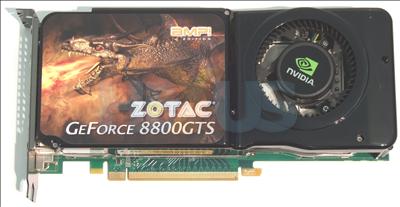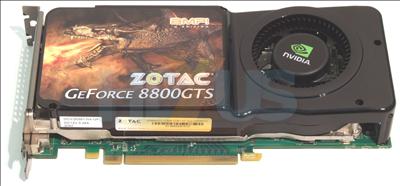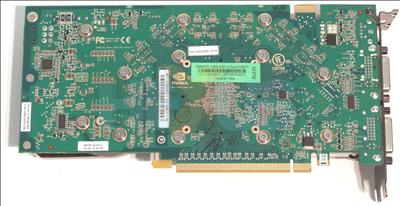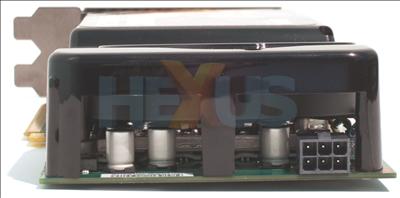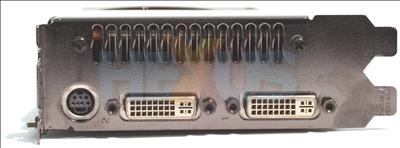GeForce 8800 GTS 512, and ZOTAC's card
NVIDIA has kept the GeForce 8800 GTS moniker intact in the move from the 320MiB- and 640MiB-equipped cards that were released around a year ago, but the GeForce 8800 GTS 512 adds in more than just a different-sized frame-buffer.
Built on a 65nm manufacturing process; endowed with 128 stream processors; a 256-bit memory interface; VP2 video-processing engine; PCIe 2.0 connectivity; and double-G80 bilinear filtering speed - its brute power will see it faster at rendering than a GeForce 8800 GTX in many cases.
The basic statistics can be though of as a GeForce 8800 GT - also recently introduced - but with performance cherries on top.
Ensuring that it remains on reasonably level footing with the G80s that it competes against, the GTS 512 is hamstrung via a 256-bit memory interface, although the near-2GHz GDDR3 clocking makes up for bandwidth deficits.
The extra oomph over and above a GeForce 8800 GT necessitates a dual-slot-taking cooler, though.
Take a look at the various stats in table-mode.
| Graphics cards | NVIDIA GeForce 8800 GTS 512 | NVIDIA GeForce 8800 GT 512 | NVIDIA GeForce 8800 GTS 320 | NVIDIA GeForce 8800 GTX 640 | NVIDIA GeForce 8800 GTX 768 |
|---|---|---|---|---|---|
| PCIe | PCIe 2.0 | PCIe 1.x | |||
| GPU clock | 650MHz | 600MHz | 500MHz | 500MHz | 576MHz |
| Shader clock | 1625MHz | 1500MHz | 1188MHz | 1188MHz | 1350MHz |
| Memory clock (effective) | 1940MHz | 1800MHz | 1576MHz | 1576MHz | 1800MHz |
| Memory interface, size, and implementation | 256-bit, 512MiB, GDDR3 | 256-bit, 512MiB, GDDR3 | 320-bit, 320MiB, GDDR3 | 320-bit, 640MiB, GDDR3 | 384-bit, 768MiB, GDDR3 |
| Memory bandwidth | 62.08GB/sec | 57.60GB/sec | 63.04GB/sec | 63.04GB/sec | 86.40GB/sec |
| Manufacturing process | TSMC, 65nm | TSMC, 65nm | TSMC, 90nm | TSMC, 90nm | TSMC, 90nm |
| Vertex, fragment, geometry shading (shared) | 128 FP32 scalar | 112 FP32 scalar | 96 FP32 scalar | 96 FP32 scalar | 128 FP32 scalar |
| Peak GFLOP/s | 624 | 504 | 342.1 | 342.1 | 518.4 |
| ROPs | 16 | 16 | 20 | 20 | 24 |
| Peak GTexel/s (bilinear) | 41.6 | 33.6 | 12 | 12 | 18.4 |
| Hardware-assisted video-decoding engine | NVIDIA's VP2 - full VC-1 decode and partial H.264 decode | run via GPU's shaders | |||
| Reference cooler | dual-slot | single-slot | dual-slot | dual-slot | dual-slot |
| Retail price (default-clocked model) | £199 | £160 | £175 | £199 | £235 |
The ZOTAC card, being based entirely on the reference design, ships with a dual-slot cooler that's barely noticeable when the card's running at full chat.
The cooler's a little different to the GeForce 8800 GTS 320/640's, and whilst the GTS 512 is higher-clocked than the G80 GTS duo, it consumes less power, thanks to a more-efficient manufacturing process.
Now, the default clocks for a GTS 512 are 650/1625/1940 for the core, shader, and memory, respectively. ZOTAC has pushed these up to 678/1728/1944 for its AMP! Edition, pushing performance up a notch or two.
Two GTS 512s can be coupled together to form an SLI team, promising near-double performance. The 512MiB of GDDR3 RAM is stitched on the upper side of the PCB.
Note that there's only a single connector for inter-GPU communication. Three-way SLI remains the domain of G80 - GTX and Ultra - cards.
NVIDIA probably could have opted for a single-slot cooler for the GTS 512, but having a dual-slot model opens up the way for some serious overclocking. A single six-pin PCIe connector provides more than enough auxillary power.
Being a modern GPU released at the end of 2007, the '512 incorporates NVIDIA's VP2 video-processing engine that takes most of the computational load from decoding VC-1 (albeit not complete) and H.264-encoded media - HD DVD and Blu-ray, for example.
Both DVI ports offer dual-link compliance, meaning you can run a couple of 2,560x1,600 panels concurrently.






